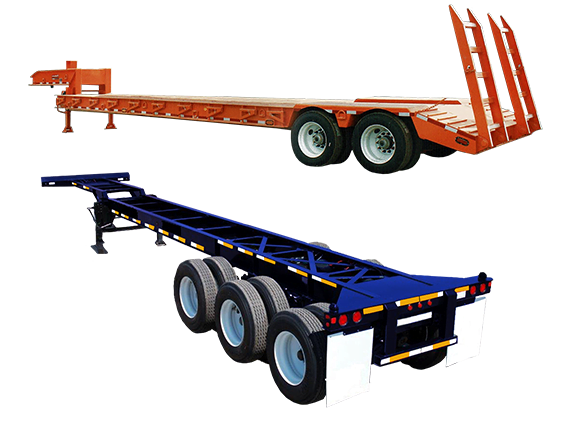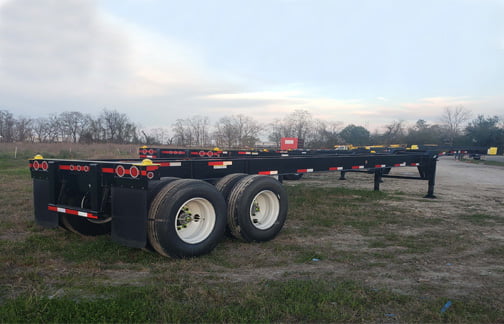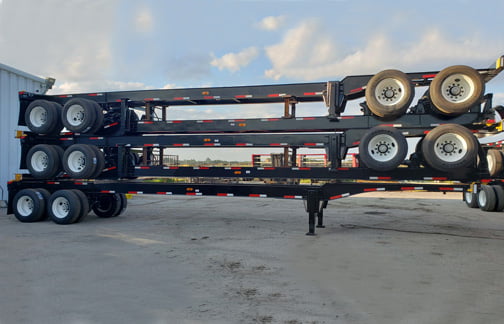What is a Container Chassis?
A container chassis, also known as a container trailer or container frame, is a specialized type of trailer specifically designed to transport shipping containers. It provides a sturdy and secure platform for carrying containers of various sizes, typically 20 ft, 40 ft, or 45 ft in length.
The main purpose of a container chassis is to facilitate the transportation of containers from one location to another, whether it be from ports to inland destinations, between distribution centers, or for other logistical purposes. Container chassis are widely used in the shipping and logistics industry, as well as in intermodal transportation, where containers are transferred between different modes of transport such as ships, trains, and trucks.
Container chassis plays a vital role in the world’s transportation and logistics infrastructure, enabling the efficient movement of containers and facilitating international trade. These are reliable and standardized means of container transportation that ensure the safe delivery of goods through various transportation networks.
It is important to note that container chassis design and functionality may vary slightly due to specific local regulations and manufacturer specifications. For the most accurate and up-to-date information regarding container chassis configurations and capabilities, we always recommend contacting reputable manufacturers or suppliers.
To discuss your container chassis needs, get in touch with Global Container and Chassis immediately to check the chassis for sale near you. We sell new and used shipping container chassis. Our experienced and knowledgeable team is ready to provide you with expert guidance and help you find the ideal container chassis.
1. Structural Integrity: Container chassis are built with robust materials, such as steel, to provide strength and durability. They are designed to handle the weight and structural demands of loaded containers.
2 . Twist Locks: Container chassis are equipped with twist locks, which are mechanisms that securely lock the corners of the container to the chassis. This ensures that the container remains securely attached to the chassis during transportation.
3. Axle Configuration: Container chassis typically have two axles or more, depending on the weight capacity and regional regulations. The axles are positioned to evenly distribute the weight of the container and provide stability during transit.
4. Suspension System: The chassis is equipped with a suspension system that helps absorb shocks and vibrations during transportation. This helps protect the container and its contents from damage.
5. Landing Gear: Container chassis feature landing gear, which is a set of legs that can be extended to support the front of the chassis when it is not attached to a truck or tractor unit. This allows the chassis to be detached and remain stable on the ground.
1. Fixed Chassis: This is the most basic type of container chassis, featuring a fixed length and configuration. It is suitable for standard-sized containers and offers a stable platform for transportation.
2. Sliding Chassis: Sliding chassis has an adjustable length, allowing the chassis frame to extend or retract to accommodate containers of different lengths. This flexibility enables the transportation of both standard-sized and longer containers.
3. Extendable Chassis: Similar to sliding chassis, extendable chassis has the ability to adjust their length. However, they have a greater range of extensions, making them suitable for transporting oversize containers or multiple smaller containers.
4. Gooseneck Chassis: Gooseneck chassis, also known as drop-frame chassis, feature a lowered front portion (gooseneck) that allows for a lower deck height. This design is advantageous for transporting taller cargo or equipment that requires additional clearance.
5. Tri-Axle Chassis: Tri-axle chassis has three axles evenly spaced along their length, providing increased load capacity and improved weight distribution. They are suitable for carrying heavier containers or cargo, optimizing payload, and reducing the number of trips required.
6. Tilt Chassis: Tilt chassis feature a tilting mechanism that allows the container to be loaded or unloaded by tilting the entire chassis. This eliminates the need for additional equipment, such as cranes or forklifts, making it ideal for situations where easy access to the container is required.
Contact us to check the container chassis for sale near you.
Container Categories
- One-Tripper
- IICL-5 Containers
- Cargo Worthy
- Wind and Water-Tight (WWT)
- As is or General Purpose
- Refurbished
- Damage Container






